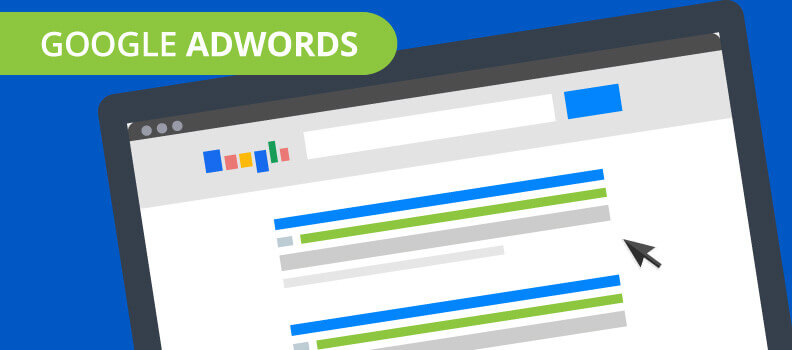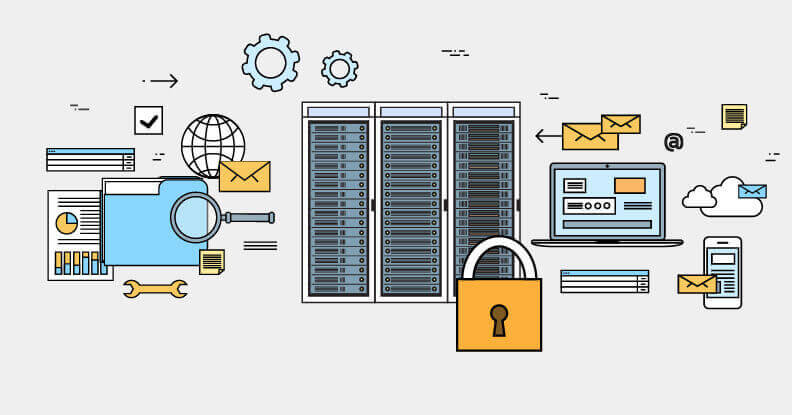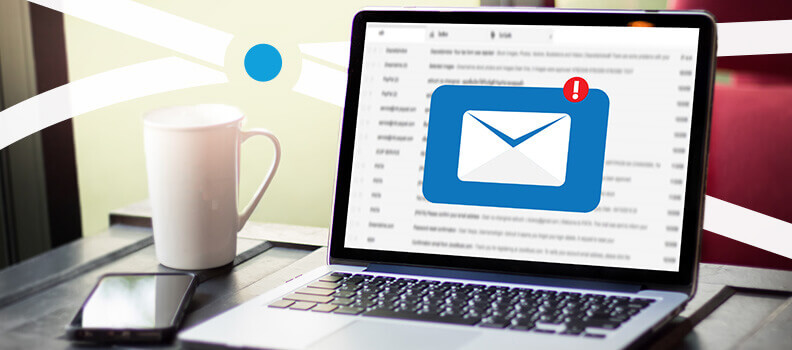Brand loyalty isn’t just a feel-good concept – it’s a critical growth driver for small and medium-sized businesses. Fostering loyal customers delivers a higher ROI because keeping existing buyers is far more cost-effective than constantly chasing new ones.
It’s equally important to understand that brand loyalty today is deeply emotional and behavioral. Customers stick with brands that resonate with them on a personal level, those that provide great experiences, align with their values, and make them feel appreciated, ultimately favoring brands that make them feel understood and valued over those that just offer the cheapest deal. In short, cultivating brand loyalty is all about building genuine relationships that keep customers coming back.
Below are 13 eye-opening statistics about brand loyalty in 2025, grouped by theme. These insights underscore how loyalty impacts revenue, why retention often beats acquisition, how loyalty programs perform, and how emotional connection drives advocacy. Use these data points to inform your customer retention strategies and stay ahead of the competition.
Brand Loyalty Insights for SMB Success in 2025
Loyalty’s Impact on Revenue
Cultivating customer loyalty directly fuels revenue growth. Loyal customers buy more, buy more often, and are far more profitable over time. The data clearly shows that businesses prioritizing retention consistently outperform competitors, underscoring why SMBs must focus strategically on keeping their customers happy, engaged, and coming back for more.
- Loyal customers are more likely to make repeat purchases and more willing to overlook mistakes.
Pro Tip: Regularly track your customer churn and repeat purchase rates. If you can nudge retention up even slightly (through better service, follow-ups, or loyalty incentives), you stand to greatly boost your bottom line without the hefty costs of finding new customers.
- “Loyalty leader” companies grow revenues roughly 2.5 times faster than their peers. Industry data shows that businesses which rank at the top of their field in customer satisfaction and loyalty dramatically outpace competitors in growth.
Pro Tip: Track customer satisfaction metrics (like NPS or repeat purchase rates) alongside your sales growth. If you improve loyalty by enhancing customer experience, you’re likely to see revenue follow.
- Returning customers spend 67% more than new customers on a given purchase. A recent analysis found that established customers have significantly higher average order values compared to first-time buyers.
Pro Tip: Maximize this by creating opportunities for repeat customers to increase their spend. For example, offer exclusive product bundles or premium service upgrades to long-term customers. Since they already trust your brand, they’ll be more receptive to trying new offerings.
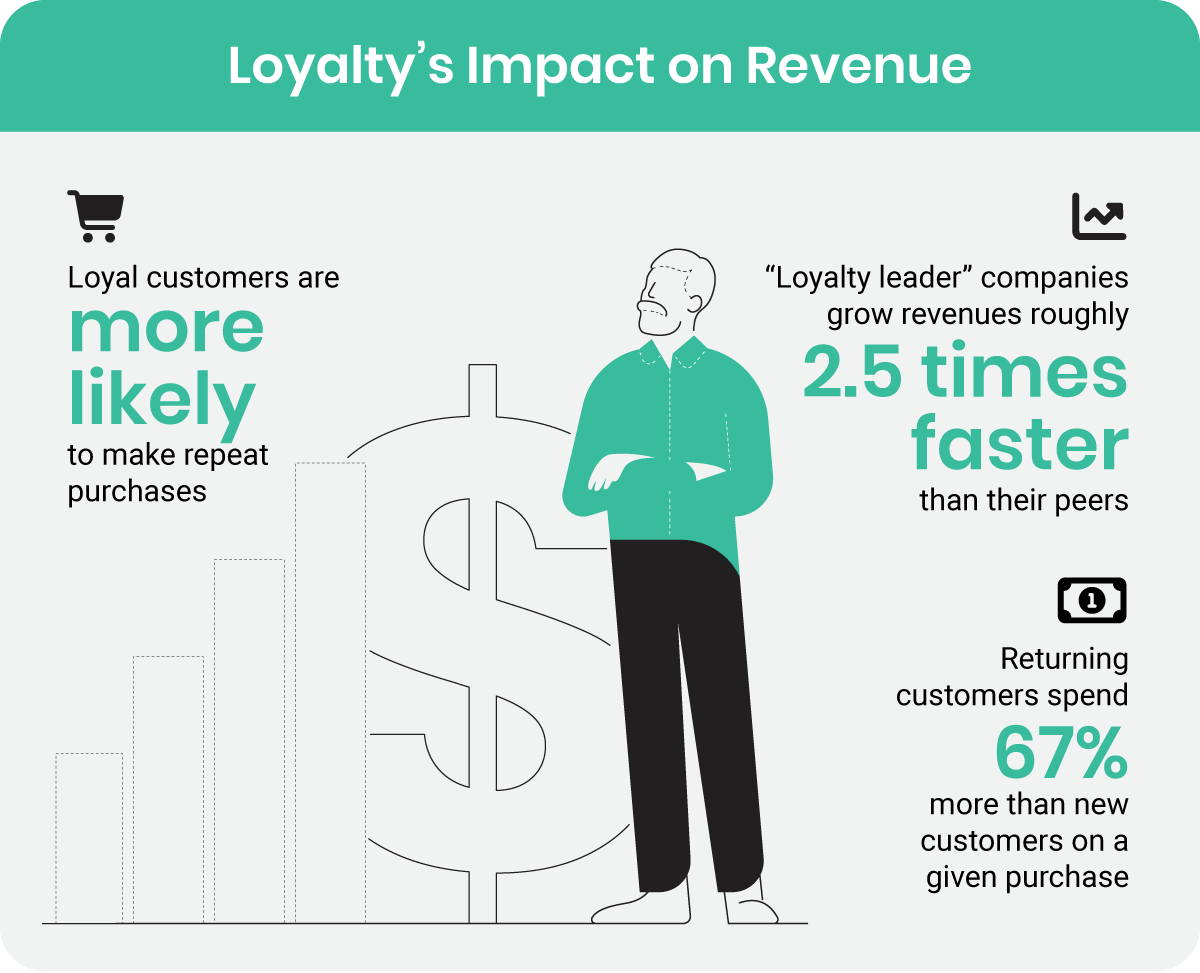
Customer Retention vs. Acquisition
Acquiring new customers is increasingly expensive and often less profitable than nurturing existing relationships. The following statistics make a strong case for why SMBs should shift their focus (and budgets) toward retention efforts. Keeping your current customers engaged isn’t just cost-effective; it’s also proven to deliver higher sales and stronger returns.
- Customer acquisition costs have risen 60% in the last five years, and today merchants lose an average of $29 on each new customer acquired. A 2024 report noted that rising digital ad costs and competition means many businesses spend more to land a new customer than that customer’s first purchase is worth.
Pro Tip: Consider implementing onboarding email sequences or loyalty offers right after a customer’s first purchase to encourage that crucial second purchase.
- It costs five times more to acquire a new customer than to retain an existing one. Dollars spent on retention (loyalty programs, customer service, personal touches) often stretch much further than the same spend on advertising or sales for new customer acquisition.
Pro Tip: Shift your mindset (and budget) to prioritize customer retention. Simple steps like follow-up calls, thank-you emails, or special loyalty discounts for existing clients can greatly increase retention at a fraction of the cost of big marketing campaigns.
- The probability of selling to an existing customer is up to 70%, while for a new prospect it’s as low as 5%. In other words, your current satisfied customers are far more likely to buy again, whereas converting someone completely new is a challenge.
Pro Tip: Since the odds of conversion are in your favor, even a simple re-engagement campaign (like notifying past clients about a new product or a seasonal sale) can produce significant sales with minimal spend.
Loyalty Program Effectiveness
Loyalty programs have become a proven tool for keeping customers engaged, spending more, and returning frequently. The stats below clearly illustrate their effectiveness, revealing why SMBs should invest in rewards and incentive programs to boost customer retention, increase average spend, and stand out from competitors.
- Around 80% of American consumers are members of at least one loyalty program. A recent Forbes report indicated that the majority of U.S. shoppers participate in loyalty or reward schemes in industries from retail to hospitality.
Pro Tip: If you don’t have a loyalty or rewards program yet, consider starting one on a scale that fits your business. It could be as simple as a digital punch-card via an app or a points system in your POS.
- Over 83% of customers who belong to a brand loyalty program are more likely to make purchases again. When customers join loyalty programs, they’re motivated by rewards, exclusive offers, and personalized experiences, making them more likely to increase their purchase frequency or spend more per transaction.
Pro Tip: Loyalty incentives do more than retain your customers—they actively encourage higher spending. By rewarding frequent buyers through exclusive offers, discounts, or personalized perks, SMBs can significantly boost the average order value and overall customer lifetime value, directly enhancing revenue and profitability.
- 62% of customers will spend more to get better loyalty rewards. Many consumers are willing to increase their spending or purchase more frequently if it helps them unlock higher tiers of benefits or rewards in a loyalty program.
Pro Tip: Structure your rewards program to incentivize slightly higher spending. Experiment with promotions like “earn double points this month for spending above $X” to see how it affects sales.
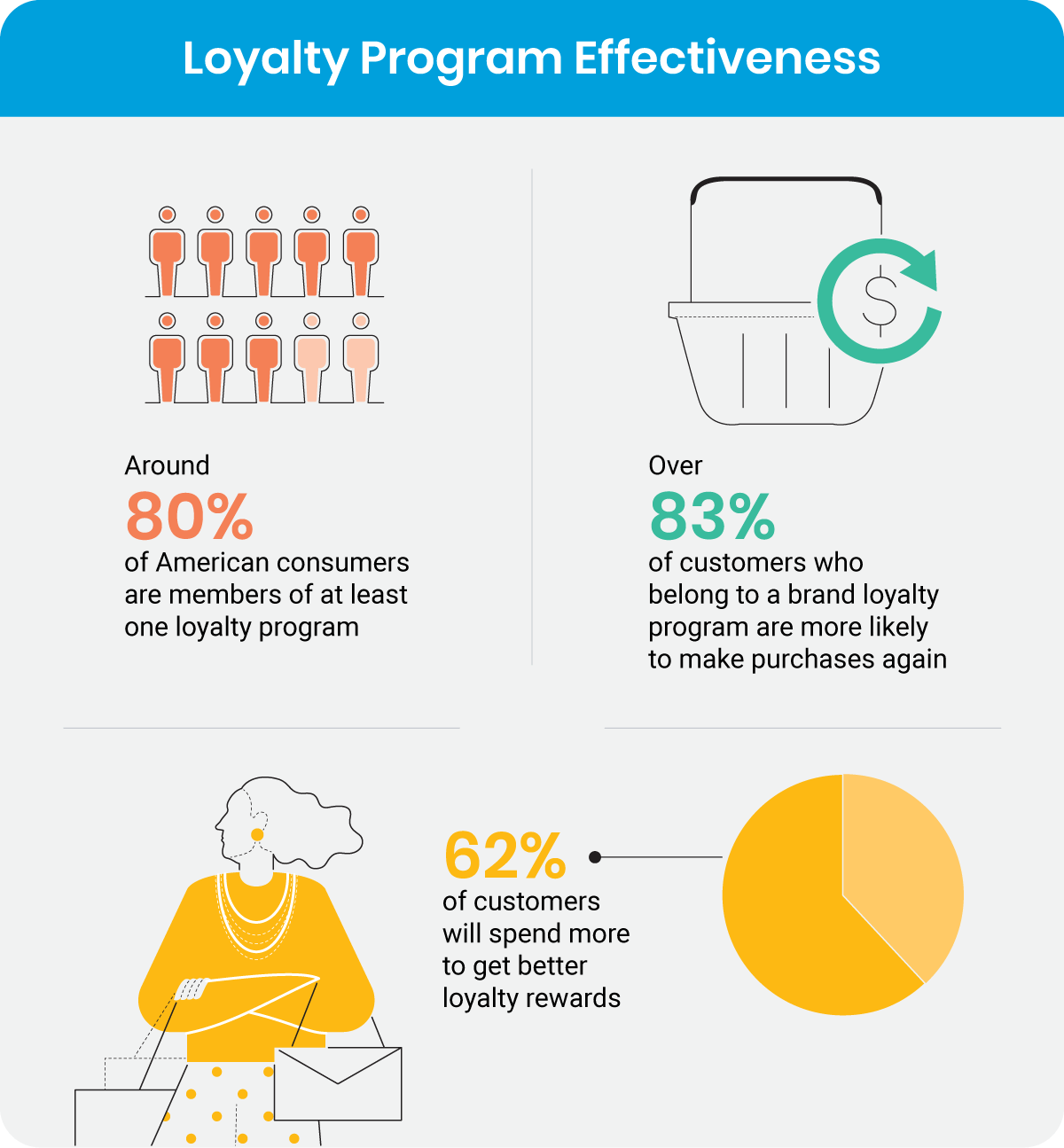
Emotional Loyalty & Brand Advocacy
Today’s customers want more than transactions. They seek brands that align with their values, earn their trust, and create personal connections. Emotional loyalty not only deepens relationships but turns customers into powerful advocates who actively spread positive word-of-mouth. The following stats illustrate the significant benefits of forging genuine emotional ties with your customers.
- 86% of brand-loyal consumers will recommend their favorite brands to friends and family. The vast majority of people who feel loyal to a brand take the extra step of telling others about it.
Pro Tip: Make it easy for satisfied customers to recommend you. This could be as simple as providing shareable referral links or cards they can give to friends (perhaps with a small discount for the new customer or a kickback for the referrer).
- 59% of consumers have a strong personal connection to the brands they’re most loyal to. More than half of customers in a recent study reported that loyalty goes hand-in-hand with feeling personally connected to a company.
Pro Tip: Tell your brand story and communicate your values consistently. If you’re a family-owned business or have a unique origin story, share it. Let customers “in” behind the scenes via social media or email newsletters.
- According to recent brand trust statistics, 81% of consumers say they need to trust a brand to buy from it. Trust significantly influences consumers’ purchasing decisions. People typically choose brands they perceive as reliable, transparent, and consistent.
Pro Tip: Building trust through honesty and reliability is essential because without trust, customers won’t stick around. SMBs should consistently demonstrate honesty, reliability, and transparency in all interactions. Clearly communicate your values, honor commitments, and promptly address customer concerns to build lasting trust and loyalty.
- 52% of global consumers go out of their way to buy from brands they’re loyal to. Over half of consumers will actually inconvenience themselves, whether by traveling extra distance, paying a bit more, or bypassing closer options, to patronize a favored brand.
Pro Tip: Reward that extra effort. If you know a customer drives across town to your store or waits for your product to be back in stock rather than buying a substitute, let them know you appreciate it. Ensure your product quality and customer service remain top-notch so that going out of their way feels worth it to them every time.
The Future of Brand Loyalty
Brand loyalty is evolving rapidly, and savvy SMBs have exciting opportunities to deepen customer connections. One major trend, personalization and loyalty, will be critical as more than 80% of customers now prefer brands that offer personalized experiences. By leveraging customer loyalty insights (like purchase history or demographics), SMBs can deliver tailored offers and memorable interactions, significantly boosting customer retention statistics.
Another key shift is toward omnichannel loyalty, where customers expect seamless interactions across websites, social media, mobile apps, and physical stores. SMBs should invest in user-friendly loyalty program technology and CRM tools, allowing customers to earn and redeem rewards consistently across all touchpoints, enhancing overall loyalty program effectiveness.
Increasingly, customers also seek brand authenticity and emotional connections. Many, especially younger generations, prefer businesses that reflect their values and support local communities. Demonstrating genuine commitment to social responsibility or community involvement helps SMBs build trust and deep emotional loyalty.
Lastly, affordable advancements in loyalty technology, like AI-driven insights and gamification, empower SMBs to compete effectively. Simple yet engaging tactics, such as rewards progress tracking or playful challenges, can boost customer engagement without large budgets.
In short, the future belongs to SMBs that master personalization, build authentic emotional connections, deliver consistent omnichannel experiences, and embrace loyalty-enhancing technology. These strategies will help businesses cultivate devoted customers, improve customer retention vs acquisition costs, and secure long-term growth well beyond 2025.
7 Loyalty-Boosting Tips for SMBs
Ready to strengthen your customer loyalty? Here are seven actionable strategies tailored for small and medium businesses:
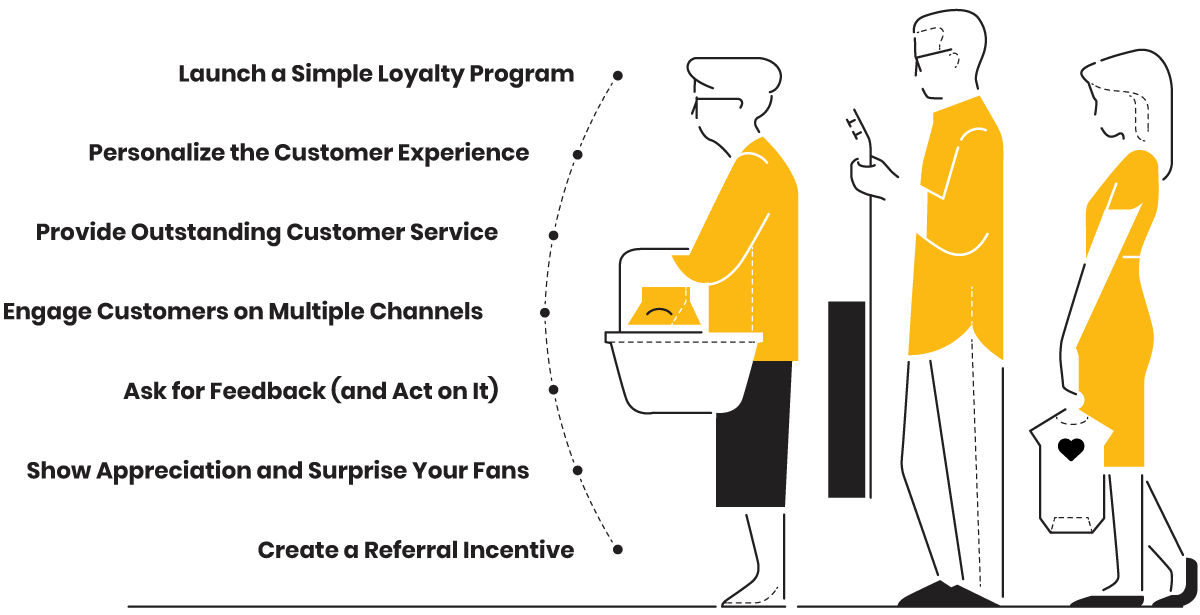
- Launch a Simple Loyalty Program: If you don’t have one yet, create a basic loyalty program to reward repeat business. This could be a points system, punch card, or tiered rewards. Keep it straightforward and attainable. For example, offer a free item after 10 purchases or exclusive discounts for members. A loyalty program gives customers a tangible incentive to choose you repeatedly.
- Personalize the Customer Experience: Leverage the personal touch that comes naturally to many SMBs. Greet customers by name, remember their usual orders or preferences, and tailor recommendations for their past purchases. Use any customer data you have to show customers you know them. Personal touches make customers feel valued and build emotional loyalty.
- Provide Outstanding Customer Service: Excellent service is one of the biggest loyalty drivers, and it’s an area where small businesses can shine. Ensure your staff are friendly, responsive, and empowered to fix problems. Respond quickly to inquiries or complaints (especially on social media or email). When customers trust that you will take care of them, they’ll stick with you even if a hiccup occurs. Consistently great service turns one-time buyers into lifelong patrons.
- Engage Customers on Multiple Channels: Stay connected with your customers beyond the checkout. Encourage them to follow your social media, join your email list, or even sign up for SMS updates – whatever channels make sense. Then, share valuable content and updates: announce new products, solicit feedback, or even just post helpful tips or uplifting stories. Being active and engaging in the channels your customers use helps keep your brand on their radar and builds a community around your business.
- Ask for Feedback (and Act on It): Invite your customers to give input through surveys, reviews, or casual conversations. Loyal customers appreciate being heard. Crucially, use that feedback to make improvements or adaptations – and let customers know you did. For example, if an eatery gets feedback about a menu item, they might tweak the recipe and announce, “You spoke, we listened!” When customers see their feedback implemented, it fosters a sense of ownership and loyalty to your brand.
- Show Appreciation and Surprise Your Fans: Small gestures can have a big impact. Thank your long-term customers with a personal note or a small freebie when they hit a milestone (like one year anniversary of shopping with you). Offer occasional “surprise and delight” perks – maybe an unadvertised free upgrade or a bonus item thrown in their bag with a handwritten thank you. Publicly recognizing loyal customers (with their permission) on social media or in-store (“Customer of the Month”) can also make them feel special. When customers feel appreciated, they’ll remain loyal and even spread the good word about your business.
- Create a Referral Incentive: Word-of-mouth is golden for SMBs, so encourage your happy customers to refer friends. Set up a referral program where both the referrer and the new customer get a benefit (for instance, “Give $10, Get $10” off a purchase). This not only brings in new business but also rewards your existing customer, strengthening their bond with you. Even if you don’t formalize a program, simply reminding customers that you appreciate referrals (and maybe giving a thank-you discount or gift when you get one) will motivate loyal customers to act as your ambassadors.
Key Takeaways
- Retention Pays: Increasing customer retention even slightly can significantly boost profits.
- Loyalty Programs Work: Customers enrolled in loyalty programs spend more and shop more frequently.
- Personalization is Key: Tailored experiences strongly influence repeat business and strengthen the customer’s emotional connection to your brand.
- Trust Matters: Transparency, reliability, and authenticity drive long lasting loyalty. And loyalty pays off in the long run.
- Emotional Loyalty Wins: Customers who feel emotionally connected tend to spend more, advocate for your company, and stick around longer.
- Omnichannel Consistency: Seamless customer experiences across multiple touchpoints enhance both loyalty and engagement.
- Tech Helps SMBs Compete: Affordable loyalty tools and simple gamification tactics enable small businesses to deliver sophisticated loyalty experiences on par with larger companies.
FAQs
Brand loyalty is a customer’s commitment to continue buying from a particular brand or business, even when there are other options. It means the customer trusts the brand and prefers it above others. For a small business, brand loyalty matters because loyal customers tend to buy more, buy more often, and refer others to your business – all of which boosts your revenue.
Loyalty programs are structured rewards systems that encourage customers to continue doing business with you. Common examples include points-per-purchase schemes (earn points and redeem them for discounts or freebies), punch cards (“buy 9, get the 10th free”), tiered VIP programs, or membership clubs. They work by giving customers an added incentive to choose you over competitors – the more they spend or engage, the more they earn towards future rewards.
Increasing loyalty doesn’t always require a big budget—often, small gestures matter most. Personalize your service by remembering customers’ names and preferences, engage regularly through low-cost channels like social media or email, reward repeat customers with surprise discounts or thoughtful extras, and actively seek their input to foster a sense of partnership. These cost-effective approaches build strong, lasting loyalty without significant marketing expenses.
SMBs can effectively compete on loyalty by leveraging advantages like personalized relationships, niche expertise, community involvement, and agility. Build genuine connections by knowing customers personally, provide specialized offerings tailored to customer needs, actively engage in your community, and quickly respond to feedback. These personal and authentic approaches often resonate more deeply with customers than large-scale loyalty programs, helping SMBs build lasting customer relationships without matching big-brand budgets.
SMBs can measure loyalty effectively using repeat purchase rate, customer retention rate, customer lifetime value, Net Promoter Score, and engagement metrics. Monitoring these metrics regularly gives small businesses valuable insights into the effectiveness of their loyalty strategies.
Turn negative experiences into loyalty-building opportunities by responding promptly and sincerely, clearly acknowledging the issue, and quickly offering a resolution (like refunds or replacements). Always follow up afterward to confirm satisfaction and communicate improvements based on their feedback. Handled well, resolving problems effectively can significantly strengthen a customer’s trust and long-term loyalty.




